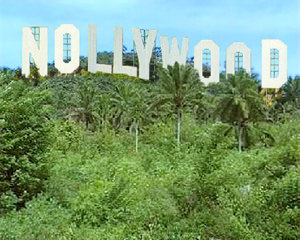Nollywood Rising
The Nigerian movie industry, known as Nollywood (a play on Hollywood in the manner of Bollywood), has grown from an accidental discovery into a mega-industry of over 2,000 titles and $200M annually. The Nigerian movie industry has grown from an accidental discovery into a mega-industry of over 2,000 titles and $200M annually.
For an industry that started purely by accident, the Nigerian movie industry (known as Nollywood) has not done badly at all. According to a new United Nations Educational, Scientific and Cultural Organization (UNESCO) report, the Nigerian film industry has overtaken Hollywood and closed the gap on India’s Bollywood, the global leader in the movie business, in terms of the number of movies produced each year. Nollywood has therefore surpassed Hollywood to become the world’s second largest film producer.
According to a UNESCO Institute for Statistics survey, Bollywood—as the Mumbai-based film industry is known—produced 1,091 feature-length films in 2006. In comparison, Nigeria’s moviemakers came out with 872 productions—all in video format. The United States, on the other hand, produced 485 major films.
The survey reports that India, Nigeria and the United States were followed by eight countries that produced more than 100 films each: Japan (417), China (330), France (203), Germany (174), Spain (150), Italy (116), South Korea (110) and the United Kingdom (104).
According to the study, American movies continue to dominate in terms of cinema admissions around the world, and all of the top 10 films seen in Australia, Bulgaria, Canada, Costa Rica, Namibia, Romania and Slovenia were U.S.-made. Nigerian films, however, outsell Hollywood films in Nigeria and many other African countries, where Nigerian video movies are available in even the most remote areas. Nollywood films also enjoy immense popularity among the African Diaspora in both Europe and North America.
The reach of Nollywood is driven by the use of English as a prominent language in its movies. The UNESCO survey reveals that 56 percent of Nollywood movies are made in Nigerian languages and 44 percent in the English language. This has contributed to Nigeria’s success in exporting its films. Aggressive marketing using posters, trailers and television advertising has also helped the expansion of the market.
Now to the accident that gave rise to Nollywood. Legend has it that in 1992, Nigerian businessman Kenneth Nnebue imported from Taiwan more blank videocassettes than he knew what to do with. To mop up the glut, he came up with the ingenious idea of recording something on them to make them more marketable. Nnebue shot a film titled “Living in Bondage” which told the story of a man who achieves power and wealth by killing his wife in a ritualistic murder, only to repent later when her ghost starts haunting him. It was a familiar story which resonated with many in Nigeria’s superstitious society. A megahit was born.
The film sold more than 750,000 copies and became what could be called a box office success, except that there was really no box office. It was shot on video and copied to Nnebue’s tapes and went straight to the streets. It held audiences captive in homes, video shops and street corners, filling a yawning gap. Movie theaters had become nonexistent in Nigeria as a result of a growing siege of crime. Armed robbery gangs ensured that it was almost impossible to go on an outing without risking life and limb, so people generally stayed indoors after dark. Home viewing therefore became the preferred mode of watching movies. Even up until now, Nigeria has virtually no formal cinemas. The UNESCO survey found that about 99 percent of screenings are in informal settings, such as home theaters.
Many would-be producers saw the potential and began spawning imitations of Nnebue’s blockbuster. An industry took off. The rise of affordable digital filming and editing technologies also stimulated the industry. Nigerian directors, more than 300 in number, began to adopt new technologies as they become affordable. Videotape cameras were ditched for digital devices, which are now being replaced by HD cameras. Editing, music and other postproduction work are done with Macs and PCs.
Before Nnebue’s feat, moviemaking in Nigeria was an unrewarding business. The first Nigerian films were made by filmmakers such as Ola Balogun and Hubert Ogunde in the 1960s, but they were frustrated by the high cost of celluloid film production. The enterprise struggled through the ’70s and ’80s in the form of local popular theater, television productions and a small-scale informal video movie trade. Home viewing depended largely on Hollywood and Bollywood movies, which provided little that Nigerian audiences could identify with. The rise of Nollywood pushed James Bond, Bruce Lee and Shashi Kapoor off the shelves and replaced them with familiar names such as Okonkwo, Kanayo, Edochie and Kosoko. A true African renaissance was born!
According to UNESCO Director-General Koïchiro Matsuura, “film and video production are shining examples of how cultural industries, as vehicles of identity, values and meanings, can open the door to dialogue and understanding between peoples, but also to economic growth and development.” Nollywood seems to have achieved all of that and much more.
Through Nollywood movies, Africans are experiencing a worldwide cultural renaissance and reengagement. Even the best foreign movies cannot possibly provide this. Recently, South Africa’s satellite TV company, Multichoice DSTV, introduced a channel called AfricaMagic, which shows mostly Nigerian movies to its subscribers in Africa, Europe and the Middle East. Viewers in the United States also watch Nollywood movies on Afrotainment. And because the films are still sold mainly on videocassette, they are so cheap and widely available that even the poor in rural areas can join the fun.
On the economic growth front, most of the films are produced by independent companies and businessmen. The industry is believed to employ about 200,000 people as producers, directors, actors, editors, distributors and promoters. According to Chike Maduekwe of Gemafrique, a film-promotion business in Lagos, there is a legion of spinoff jobs on a typical film set, such as makeup, props and printing, and young people without a formal education can find a place. The Nigerian National Film and Video Censors Board ranks Nollywood as the biggest employer after agriculture. The industry employs a million people a year and contributes about $250 million to the Nigerian economy. About 30 new titles are released every week. An average film sells 50,000 copies. While less popular titles will sell 10,000 copies, megahits can sell between 200,000 and 400,000 copies.
Beyond the glitz and glitter that is usually associated with the world of movies, however, the story of Nollywood is one of hope and resilience, according to Italian (Zambian-born) filmmaker Franco Sacchi, who studied the industry and concluded that “one can only admire the low-budget effectiveness crossed with lunacy that characterizes Nollywood gumption.”
Anyone familiar with the elaborate preparations that go into the making of Hollywood movies would certainly call Nollywood a crazy industry. Most movies are not produced in studios. Video movies are shot on location in hotels, homes and offices which are often rented out by their owners. These emergency studios are usually acknowledged in credits in the movies. The most popular locations are in Lagos, Enugu and Abuja.
The films are made on shoestring budgets of time and money. An average production takes about 10 days and costs approximately $15,000. Nollywood’s most prolific director, Chico Ejiro, who directed over 80 films in an eight-year period, reportedly brags that he can complete production on a movie in as little as three days.
Actual shooting is no less crazy. Saachi reports that shooting is usually delayed by obstacles that are unheard of in Hollywood. Star actors, often working on several films at the same time, are not usually punctual for shooting. And this is not always because they are exhibiting star power. Lagos, for instance, is a city of unimaginable urban chaos, where about 20 million people negotiate their existence in the midst of hectic traffic. Frequent power outages also help to hold things up. Location shooting is often delayed by local thugs (known as area boys) who extort money for protection before they will allow filming to take place in their territories. Such scenes are commonplace in a country with high unemployment figures and very few opportunities for self-actualization.
Despite the craziness, Nollywood has carved a niche which has made many describe it as an African, if not a global, phenomenon. Africa’s rich tradition of storytelling, which has been expressed over the ages through oral and written fiction, had never been conveyed through the mass media. Nollywood is therefore a milestone for the African continent. The stars are Africans, and the movies tell African stories with familiar African settings. The plots usually hover thematically around despair resulting from greed, corruption and love-gone-wrong and redemption through repentance and restitution. Witchcraft and the occult are often thrown in for exotic effect.
“We are telling our own stories in our own way,” Bond Emeruwa, one of Nollywood’s prolific directors, says. “That is the appeal both for the filmmakers and for the audience.”
And the world seems to be watching and waiting. Celebrated American actors Forest Whitaker and Danny Glover presented awards at the African Movie Academy Awards in May. Vanessa Williams presented at a previous edition. Also, Wesley Snipes has called to check out prospects for collaboration.
Nigeria’s film industry was the subject of the 2007 documentary “Welcome to Nollywood,” by director Jamie Meltzer. The documentary premiered at the Full Frame Documentary Film Festival, and also played at the Avignon Film Festival and the Melbourne International Film Festival in the summer of 2007. It gives an overview of the industry and acknowledges the rapid and enterprising way that most Nollywood films are created, as well as its significance and contribution to the greater society.
Franco Sacchi’s 2007 documentary “This Is Nollywood” also features interviews with Nigerian filmmakers and actors as they discuss their industry, defend the types of films they make and detail the kind of impact they can have. Sacchi presented the film at the TED conference in 2007.
The 2007 Danish documentary “Good Copy Bad Copy” focuses substantially on Nollywood’s direct-to-DVD distribution and the industry’s reliance on off-the-shelf video editing equipment as opposed to the more costly traditional film process.
Nollywood was also profiled in a 2008 Canadian documentary “Nollywood Babylon,” co-directed by Ben Addelman and Samir Mallal and produced by AM Pictures and National Film Board of Canada in association with the Documentary Channel. The documentary played in the Official Competition at the Sundance Film Festival in January 2009.
The African Movie Academy, a pan-African group which focuses on research, training and propagating filmmaking in Africa, pays tribute to Nigeria’s pioneering role in moviemaking in Africa by devoting an entire category—The Heart of Africa Award—to the best films made in Nigeria.
The African Movie Academy Awards is the biggest gathering of moviemakers across the African continent and the African Diaspora. The 2009 edition, held in Nigeria’s Bayelsa state in April, recorded the most continental presence so far, with entries coming from Nigeria, Ghana, Cameroun, Niger, Egypt, South Africa, Uganda, Burkina Faso, Kenya, Rwanda and Zimbabwe.
Kenya was the star of the show. The Kenyan movie “From a Whisper,” which commemorates the 10th anniversary of the Aug, 7, 1998, terrorist bombing in Kenya in which over 250 people died and 5,000 were injured, won the most awards. The movie earned laurels in the best director, screenplay, picture, original soundtrack and achievement in editing categories.
“Gugu Andile,” a South African movie, won the award for best performing actor in a leading role, while the Egyptian movie “Seventh Heaven” won the best performing actor in a supporting role and achievement in sound awards. Uganda’s only entry, “Battle of the Soul,” won the achievement in visual effect award.
Nigeria took home eight awards in the best performance by an actress in a leading role, best performance by an actress in a supporting role, best child actor, achievement in costume, achievement in makeup and achievement in cinematography categories.
The Award Jury acknowledged that Nollywood “established the template for the creation of images produced by African filmmakers, for African audiences throughout the continent, its Diaspora and indeed the world.”
Nollywood has many critics, even in Nigeria. Because the movies are usually low budget, and shot under constraints of time and infrastructure, the quality is often far from the best. The acting is also sometimes amateurish, overdramatic and far from Oscar-grade. Some of the movies are overly religious, promoting evangelical Christianity or firebrand Islam. Many also argue that the plots are repetitive, and constantly hover around corruption, witchcraft and demonic possession, oftentimes reinforcing negative stereotypes about Nigeria, nay Africa.
Nollywood is, however, not without its redeeming value. Apart from growing from nothing into an industry employing thousands, it has helped to liberate the creative energy and potentials of Nigerians, which otherwise would have remained untapped. It has indeed become the nation’s greatest cultural export.
And for a country like Nigeria, which is usually in the news for all the wrong reasons – religious unrest, environmental pollution, kidnapping of oil workers, official corruption, internet fraud, and the like, Nollywood, in spite of its shortcomings, is one good thing that has come out of “Nazareth.”
Your support matters…Independent journalism is under threat and overshadowed by heavily funded mainstream media.
You can help level the playing field. Become a member.
Your tax-deductible contribution keeps us digging beneath the headlines to give you thought-provoking, investigative reporting and analysis that unearths what's really happening- without compromise.
Give today to support our courageous, independent journalists.






You need to be a supporter to comment.
There are currently no responses to this article.
Be the first to respond.